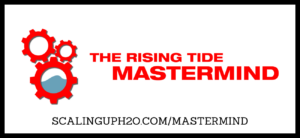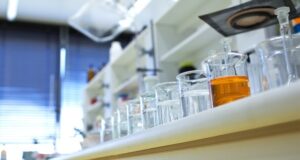 “Don’t be afraid to ask questions early and often when working with engineering firms or general contractors on your water treatment program… Getting it right the first time is the easiest and least painful way to a long-term successful water treatment program.” – Walker Burnette
“Don’t be afraid to ask questions early and often when working with engineering firms or general contractors on your water treatment program… Getting it right the first time is the easiest and least painful way to a long-term successful water treatment program.” – Walker Burnette
In this episode of the Scaling Up H2O podcast, host Trace Blackmore sits down with Walker Burnette, Water Treatment Consultant at Southeastern Laboratories to explore the importance of early involvement in water treatment projects for new and expanding facilities. Together, they uncover essential lessons, challenges, and best practices that can make or break long-term success in industrial water management.
A Chance Encounter That Sparked a Career
Walker Burnette’s journey into the water treatment industry began unexpectedly when he reconnected with Steve Tuning, a lifelong family friend and his father’s college roommate, at his former workplace. This chance meeting led to a conversation that launched his career in water treatment. Now, Walker’s former employer has become his client, showcasing the unique blend of personal history and professional growth that shaped his path.
Bridging Water Treatment Gaps in Construction
Walker Burnette addresses the common oversight of water treatment during new and expanded construction projects. In North Carolina’s fast-growing landscape, Walker has seen firsthand how rushed timelines can lead to missed steps in planning. Sharing lessons from successes and pitfalls, this discussion aims to highlight essential practices to ensure water treatment is prioritized and integrated effectively from the start.
What steps do you take to set yourself up for success in the bid process?
Walker Burnette emphasizes the importance of understanding a facility’s unique requirements when bidding on water treatment projects. Recognizing that each system may need specialized solutions, he advises focusing on value rather than competing solely on price. While not every bid will be successful, prioritizing quality and comprehensive proposals leads to long-term success and better client outcomes.
Why do you need to have relationships with people?
Walker Burnette highlights that building strong relationships is key in the competitive world of water treatment project bidding. Helping clients understand the value behind different approaches can set you apart. When clients receive various bids, confusion can arise about the differing strategies. Having a trusted relationship allows you to step in, clarify the benefits, and guide them through making an informed decision. Establishing a reputation with engineering firms and past collaborators can often lead to winning projects for the right reasons—trust and proven expertise.
Prioritizing Communication for Water Treatment Success
Clear communication and proactive planning in water treatment projects is essential. He recommends reviewing P&IDs (Piping and Instrument Diagrams) early to find cost-saving opportunities and streamline processes. Staying engaged throughout the project ensures inspections and coordination, preventing last-minute issues and promoting smooth execution.
Checklist for Water Treatment Project Planning and Execution:
1. Identify System to be Treated: List systems requiring treatment and needed equipment/chemicals.
2. Verify Lead Times: Confirm equipment lead times and communicate any delays to the end user.
3. Set Project Timelines: Track key delivery dates and installation milestones.
4. Plan for Pipe Cleaning/Passivation: Ensure pipes are flushed or treated before startup to avoid issues.
5. Communicate with Stakeholders/End Users: Keep the end user informed and ensure all steps are completed for a smooth project launch.
The Critical Step of Passivation
Passivation is presented as one of the most important phases of commissioning new systems. Walker and Trace discuss why passivation is often overlooked, the consequences of skipping it, and how to effectively advocate for this essential step.
Considering All Stakeholders and EH&S in Water Treatment Projects
Understanding the needs of all stakeholders, including engineers, contractors, operators, and end-users, is essential in water treatment projects. Involving the Department of Environmental Health and Safety (EH&S) early ensures chemicals are compatible, stored correctly, and disposed of safely. Walker emphasizes addressing these considerations from the start positions water treatment professionals as proactive consultants, avoiding last-minute issues and disruptions to project timelines.
Integrating New Equipment in Existing Facilities
Adding new equipment to an existing facility requires careful planning. Unlike new buildings, end-user involvement is higher as the facility is already operational. He stresses that new systems often need isolation and separate treatment before integration, as simply connecting and activating them can lead to issues. Proper preparation and communication are key to successful integration.
Join the Conversation
Have any thoughts on today’s episode? Join the Scaling Up H2O community by sharing your experiences and insights on proactive water treatment. Connect with us on LinkedIn, share your takeaways, or join the discussion on industry challenges and best practices.
Stay engaged, keep learning, and continue scaling up your knowledge!
Timestamps:
01:30 – Trace Blackmore shares discussion on Friday the 13th superstitions and their origins, including historical and cultural references.
05:05 – Trace Blackmore’s encouragement to review lessons from 2024 and plan for 2025, mentioning Brian Moran’s “12 Week Year”
07:09 – Upcoming Events for Water Treatment Professionals
09:25 – Interview with Walker Burnette, Water Treatment Consultant at Southeastern Laboratories about water treatment considerations during new and existing facility constructions, and the importance of early involvement in the planning process.
50:57 – Drop by Drop with James McDonald
Quotes
“Passivation might be one of the most important parts of starting up your water treatment systems—it ensures the longevity and proper function of your equipment.” – Walker Burnette
“The only person we can fix is ourselves. It’s easy to blame externally, but we need to ask the right questions and guide our customers to success.” – Trace Blackmore
“Being proactive and communicating effectively is key. When you’re adaptable, you’re more equipped to lead projects to success rather than being a reactive passenger.” – Walker Burnette
“Learning to have hard conversations with customers is a difficult skill, but once you do, you’ll never regret it.” – Walker Burnette
Connect with Walker Burnette
Phone: 336.207.7086
Email: [email protected]
Website: https://www.selaboratories.com/
Linkedin: https://www.linkedin.com/in/walker-burnette-cwt-57076465/ https://www.linkedin.com/company/southeastern-laboratories-inc-/
Read or Download Walker Burnette’s Press Release HERE
Guest Resources Mentioned
Extreme Ownership by Jocko Willink and Leif Babin
Comfort Crisis by Michael Easter
Scaling UP! H2O Resources Mentioned
Audible (free month with this link)
AWT (Association of Water Technologies)
Scaling UP! H2O Academy video courses
Submit a Show Idea
The Rising Tide Mastermind
12 Week Year: Get More Done in 12 Weeks than Others Do in 12 Months by Brian P. Moran & Michael Lennington
Drop by Drop with James
In today’s episode, I’m on my soapbox. My soapbox topic is…conductivity versus TDS…or Total Dissolved Solids. You might have expected something a little meatier, but conductivity and TDS are often used interchangeably. FAR too often they are. They are NOT the same thing though. Conductivity and TDS may be RELATED, but they measure two COMPLETELY different things. Conductivity measures the ability of a water solution to conduct an electrical current. It is quick and easily automated, only requiring a conductivity probe and a meter. Total Dissolved Solids or TDS, on the other hand, is the concentration of dissolved solids in a water solution. Measuring the TDS requires evaporating a volume of water to dryness and weighing the solids that remain. TDS takes a lot more time and labor to perform than a conductivity test.
So how are conductivity and TDS related? The conductivity of water is determined by the type and concentration of dissolved solids. Low TDS solutions typically have lower conductivities. High TDS solutions typically have higher conductivities. There can be a relationship between the two. If the water quality is consistent, conductivity can provide a practical way to monitor the TDS, but this relationship should be verified regularly.
Some may be thinking, “But my handheld meter displays the answer in TDS. What gives?” Your handheld meter is doing math internally to convert from conductivity, which is measuring, to TDS. It is not ACTUALLY measuring TDS. As a rule of thumb in the industrial water samples we often see, the actual TDS is typically 65-75% of the measured conductivity. This can vary, however, depending upon the ions in the water.
Events for Water Professionals
Check out our Scaling UP! H2O Events Calendar where we’ve listed every event Water Treaters should be aware of by clicking HERE.





